
 |
| See of GLOUCESTER. |
Azure, two keys in saltire or--See of GLOUCESTER.Keys, Ashen. See Ash.
Gules, two keys in saltire or--CHAMBERLEYN.
Gules, three pairs of keys in saltire or; on a chief as many dolphins naiant argent--Company of SALT-FISHMONGERS[in stained glass at Canterbury].
Azure, three pairs of keys, two in chief and one in base or; each pair addorsed and conjoined in the rings, the wards in chief--ABBOTSBURY Abbey, Dorset.
Gules, two keys endorsed in saltire between four cross crosslets fitchy or--See(and Deanery) of PETERBOROUGH.
Gules, on a chevron between three keys argent as many estoiles of the field--Matthew PARKER, Abp. of Cant. 1539-75.
Gules, three keys, enfiled with as many crowns or--Robert ORFORD, Bp. of Ely, 1303-10.
Argent, two bends nebulé within a bordure gules charged with twelve pairs of keys addorsed and interlaced with rings or, the wards in chief--EXETER College, Oxford[i.e. Arms of Bp. STAPLEDON, founder, A.D. 1314],
Argent, a bend sinister sable in chief an annulet gules, in base a griffin's head erased of the second, holding in his break a key azure--KAY, co. Durham; also Scotland.
Gules, three keys fessways in pale, wards downwards or--GIBSON, Scotland.
Per chevron dovetail ermine and gules, three keys erect or--KEY, co. Gloucester; also KEY, Lord Mayor of London, 1830-31.
Per chevron gules and sable, three keys or, the wards of the two in chief facing each other, those of the one in base to the sinister--Roger KEYS, Clericus[granted by HEN. VI. 1449].
Azure, three fleurs-de-lis, two and one, and as many keys, one and two, or--SHELLETOE.
Azure, three fleurs-de-lis or, one and two, and as many keys of the last two and one--SHILECORNE, co. York.
Azure, flory and a lion rampant or; over all on a bend gules three keys gold--Benedictine Priory at HOLLAND, co. Lancaster.
Keys occur in the insignia of the following Sees: CASHEL; DOWN AND CONNER; DROMORE; GLOUCESTER; EXETER; JAMAICA; KILLALOE; OSSORY; PETERBOROUGH; QUEBEC; SAINT ASAPH; WINCHESTER; YORK.
Of the following Abbeys and Religious Houses: ABBOTSBURY, Dorset; BATH; BOURNE, Lincolnshire; BROMME, Hants; CHERTSEY, Surrey, ELY; S.Peter's, GLOUCESTER; HYDE, near Winchester; HOLLAND, Lincolnshire; S.Mary de MENDHAM, Yorkshire; MUCHELNEY, Somerset; PENWORTHAM, Lancashire; PETERBOROUGH; PLYMPTON, Devon; THURGARTEN, Norfolk.
Of the following Cities and Towns: MONTGOMERY; PETERBOROUGH; SALISBURY; SAINT ASAPH; BATH; GUILDFORD; TOTNES.
The Deaneries of ST.ASAPH, WELLS, and YORK. (Peterborough Deanery bears the same arms as the See.)
Argent, on a mount a bear standing against a tree all proper, the bear collared and chained or, between two escutcheons in fesse, each charged wit the arms of France and England quarterly; on a chief argent a king crowned and habited proper holding in his dexter hand a mound and in the sinister a sceptre both or--Town of BERWICK-UPON-TWEED.Kings of Arms. See Heralds.
Sable, a king enthroned proper--IRELAND; Harl. MS. 4039.
 |
| DE INSULA. |
Gules, on three bezants the Kings of Cologne[elsewhere blazoned as three bezants each charged with a crowned king, his robes sable doubled ermine, holding in his right hand a covered cup and in his left a sword of the second]--LYLDE, Thomas DE LISLE, or DE INSULA, Bishop of Ely, 1345-61.Kingfisher: this bird seems to be borne by at least two families, and in one branch of the second family it is, oddly enough, blazoned gules.
Per fesse argent and azure a pale counterchanged three kingfishers of the second--HONYTON.Kite. See Falcon.
Or, three kingfishers proper--FISHER, London.
Or, a kingfisher close gules--FYSHER, co. Bedford.
 |
| Pruning-knife. |
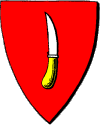 |
| BLOOD. |
Gules, a knife argent, haft or--BLOOD.Knights: Knights is a title of a honour derived from the old English Cniht, a servant or attendant, which refers to those who attended kings upon horseback, whence the name by which the knight is distinguished in other languages, e.g. chevalier, ritter, &c. In medieval Latin, however, the term miles is used instead of eques.
Azure, three knives argent, hafted gules--KNYVETT.
Gules, three knives argent--WORSYCKE.
Quarterly first and fourth gules, three knives erect in fesse argent handles or, second and third azure, three scourges erect in fesse or with three lashes to each--CROWLAND, Benedictine ABBEY, co. Lincoln.
Argent, three shoemaker's knives gules--HACKLET.
Azure, a cutting-knife proper ensigned with a marquess's coronet or--CORDNERS' Company, Edinburgh.
Argent, three shredding-knives sable--ABBOT, co. Salop.
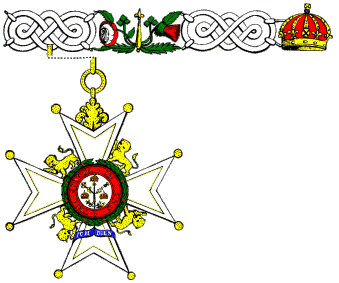 |
| Collar and Badge of Knights of the Bath. |
Nine imperial crowns of gold(five demi arches visible, no caps) and eight roses and thistles[the shamrock has been added subsequently] issuing from a sceptre, all enamelled proper, linked together with seventeen white knots.Badge of the Order of the BATH.
An oval plate azure, charged with a sceptre in pale, from which issued a rose and a thistle, between three imperial crowns proper; the whole within the circle of the order.A banner of arms was also directed to be suspended over the stall of each Companion in King Henry VII.'s chapel at Westminster.
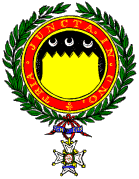 |
| Circle and Badge of the Order of the Bath. |
Or, on a chief indented sable, three crescents argent--Adm. Sir Eliab HARVEY, G.C.B.(b.) Knights commanders(K.C.B.), who must be officers holding commissions in the British army or navy. They are not permitted to use supporters, but may place their arms within the red circle, with a similar, but somewhat smaller badge pendent. The number was originally fixed at 180, exclusive of ten honorary knights, who were to be foreigners holding commissions in the English service.
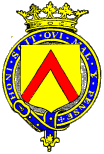 |
| The Garter. |
Or, a chevron gules--Edw. STAFFORD, Duke of Buckingham(ob. 1521).
 |
| The Collar of the Order of the Garter. |
 |
| DOCWRA. |
Sable, a chevron engrailed argent, between three plates, each charged with a pallet gules; on a chief of the last a cross argent--Sir Thomas DOCWRA.VII. The most distinguished Order of SS. Michael and George. An order which was founded by King George IV. when Prince Regent, April, 1818, in commemoration of he republic of the Ionian islands being placed under the protection of Great Britain. The sovereign of Great Britain being protector of the United States of the Ionian islands, was also Sovereign of the order of SS.Michael and George. The Grand Master was the Lord High Commissioner of the United States of the Ionian islands for the time being. The order has been much modified of late, and is now used as a reward for services in the colonies. It consists of three classes, Knight Grand Crosses, Knights Commanders, and Knights Companions. The principal officers are two Prelates, a Chancellor, a King of arms, and a Register.
A plain red cross fimbriated with gold, upon the intersection eight-foiled compartment(composed of four pointed leaves in cross, and four round ones in saltire) sable, edged or, and charged with an agnus Dei proper.IX. The Order of S.Patrick. An order instituted by King George III. for his kingdom of Ireland, Feb. 5, 1783. It consists of the Sovereign, the Grand Master, who is the Lord Lieutenant of Ireland for the time being, and knights, originally fifteen in number, but at present more, the first of whom is always a prince of the blood royal. Each knight has three esquires. The first investiture took place at Dublin Castle, March 11, 1783, and the first installation in the cathedral of S.Patrick on the 17th of the same month.
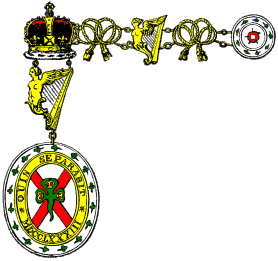 |
| Order of S.PATRICK. |
Six harps and five roses(each rose with a bordure charged with trefoils) alternately disposed, and connected by twelve knots. The central place is occupied by a royal crown, to which the badge is appended by another harp.When the collar is not placed around the arms of a knight, this badge may be suspended below them by a light blue ribbon. The Star is of chased silver, similar to that of S.Patrick, but with the badge is the centre, surrounded by a circle, which bears the motto.
An oval plate argent, charged with a saltire gules, surmounted by a trefoil slipped proper, on each to be an imperial crown of the last. The oval plate has two borders, the innermost or, with the motto QUIS SEPARABIT, MDCCLXXXIII., the outer argent, charged with about sixteen trefoils proper--Badge of the Order of S.Patrick.
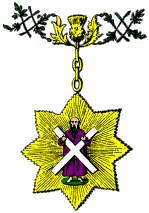 |
| Order of the THISTLE. |
Golden thistles and sprigs of rue enamelled proper--The Collar.The jewel, worn attached to a green ribbon, consists of an oval plate argent, charged with the same figure proper, within a border vert, fimbriated(both internally and externally) or, and inscribed, in letters of the same, NEMO ME IMPUNE LACESSIT. In the base of this border is a thistle of the last. The ribbon of the order may encircle the arms of knights instead of the collar, the jewel being appended to it.
A radiant star of eight points, charged with a figure of S.Andrew proper(his gown green and surcoat purple), standing upon a mount vert, and supporting his cross argent--The Badge of the Order of the THISTLE.
The collar is composed of a Lotus-flower of four cusps, two palm branches set saltire-wise, and tied with a ribbon; alternating with an heraldic rose; all of gold, enamelled proper, and connected by a double chain, also of gold. In the centre, between two Lotus-flowers, is placed an imperial crown enamelled proper, from which by a small ring depends the badge.XV. With the above should perhaps be classed The Royal Order of Victoria and Albert. This illustrious order also was instituted by her Majesty on Feb. 10, 1862, in commemoration of her marriage with the late Prince Consort, but it is conferred solely upon Ladies. The institution was primarily for conferring an order upon her Majesty's female descendants, and the wives of her male descendants, as well as upon queens and princesses of foreign houses connected by blood or amity, but consists now of three classes.
The badge is a chamfered mullet set with brilliants, below which is an oval medallion of onyx cameo, having a profile bust of her Majesty; the whole encircled by a bend enamelled azure fimbriated with brilliants, bearing the motto of the order, 'Heaven's light, our Guide.'
Argent, a knitting-frame sable garnished or, with work pendent in base gules. Supporters: the dexter a student of the University of Oxford vested proper; the sinister a woman proper vested azure, handkerchief, apron, and cuffs to the gown argent; in her dexter hand a knitting-needle, and in her sinister a piece of worsted knit gules--Company of FRAMEWORK KNITTERS.Knots. See Cords.